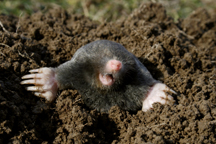Moles
 Several species of mole exist across the United States, but the Eastern Mole is the most significant pest. Not only is it the most widespread variety, it also has the highest population count. Moles grow to be roughly 7 inches in length. They have velvety, grayish fur and a hairless, pointed snout. Due to their subterranean existence, moles have no external ears and eyes so small that they appear to be missing. The mole’s most identifying characteristic is their paddle-like fore feet and stout claws, the better to tunnel with.
Several species of mole exist across the United States, but the Eastern Mole is the most significant pest. Not only is it the most widespread variety, it also has the highest population count. Moles grow to be roughly 7 inches in length. They have velvety, grayish fur and a hairless, pointed snout. Due to their subterranean existence, moles have no external ears and eyes so small that they appear to be missing. The mole’s most identifying characteristic is their paddle-like fore feet and stout claws, the better to tunnel with.
Moles are not rodents, but insectivores. They feed on insects and snail larvae, but prefer eating grubs. Their favorite food, however, is earthworms. They are voracious eaters, consuming up to 80 percent of their body weight daily, actively feeding both day and night at all times of the year.
While they typically pose no real threat, moles’ tunneling can create unsightly disturbances in lawns, gardens, golf courses and cemeteries. Although burrowing activity takes place year-round, it peaks during warm, wet months.
While some tunnels are travel lanes, located 3 to 12 inches below the surface that may be abandoned immediately after being dug, main passageways and nesting cavities can be 40 inches deep. These permanent tunnels result in what is known as “molehills,” mounds of soil brought to the surface while burrowing. In addition to softening the earth to the point of becoming unstable, tunneling can expose roots to the open air, depriving them of the necessary nutrients.
Our Approach:
Depending on the yard and surrounding environment, we use two methods for removing moles: Traps and worms. Regardless of the method(s) used, periodic inspection is necessary, in order to assess the need for possible adjustments. For example, resetting the trap(s), and/or adding more worm bait. In addition, once the initial problem is resolved, we offer ongoing maintenance programs, to ensure that any return in activity is dealt with before it becomes a nuisance.
